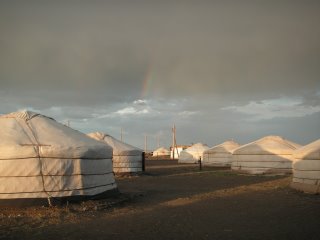
This is the picture I meant to start yesterday's blog with, err ... with which I meant to start ... yeah I know ... Since these postings are most recent first if anyone reads through in backward sequence this is the image that should start the September 12 blog. I got the pictures in it reversed. The second quilt picture shows most of the quilt.
Today's federal grand jury sessioin was short, one presentation from 12:00 to about 12:45. So I had most of the day and spent the early part removing paper foundation and then adding batting and backing to the 14th of my "star quartet: series about which more at some future time. I had time for a few errands and when I got home from the jury [more about that at another time too] I decided to finish the Mongolia set ... looking at the Mongolia pictures yesterday inspired me. I did the Lake Koshovl and the Gobi sections months ago and got waylaid by other projects. I'll do pictures of these in the near future too.
Since almost no one knows geography if it's an exotic place -- like almost anywhere you haven't actually been -- here's a brief geography of Mongolia. First you always hear of "Inner" and "Outer" Mongolia ... this is a Chinese viewpoint. "Inner" is the bottom half of the Gobi Desert which makes up a section of Northeastern China, north of Beijing. "Outer" is a dated term. Mongolia is a democracy and was one of the first countries to break away from the former USSR -- peacefully. It was occupied by Russians from the '40s through the [I'm fuzzy] late '80s, I think. Anyway, it's essentially a lozenge shaped country, pretty large, but with a very small population.
The southern section of Mongolia is Gobi Desert, this includes the Flaming Clikffs area were, in the early 1900s Roy Andrews Chapman of the NYC Natural History Museum found a trove of dinosaur bones -- and all the ones kids see in the museum were found him him there. The entire middle section of Mongolia is steppes -- rolling hills, home of nomadic people who live in gers -- which the Russians called "yerts" -- gers, rhymes with bears. They are horse and sheep people. It's a wide open land, thrilling to be in.
To the far west are the Altai Mountains. These are on the Russian border and many people who live there are tribal peoples who keep reindeer and still follow shamistic way of life. The northern portion of Mongolia is tiaga -- it borders Siberia. It is hilly,forested with ever greens and contains Lake Khovskol, which connects to Lake Baikel in Russia -- the deepest and purest and biggest inland lake in Asia.
All that is said because I love sharing information and think it's wonderful when people learn more about the world in which we live. But mainly to explain my three little wall quilts. One big one seemed overwhelming to plan and make, but two small ones, Gobi and Hovskol were fun to make, and now that I've begun the steppes section -- which is the size of the to others together -- as it should be, logically -- I'm liking it a lot too. I have to transfer a couple of photos and then I can go on with it. More later.
I'll see about a photo here at the bottom of one of the ger camps at which I stayed. I might point out that the Mongolians have NO sense of privacy or personal modesty as far as I can tell. We visited many gers, all are totally open plan. This was a "little" trying in the cases when there were three beds and I shared a ger with a married couple. ... Well, hey, we were all adults. We coped.








No comments :
Post a Comment